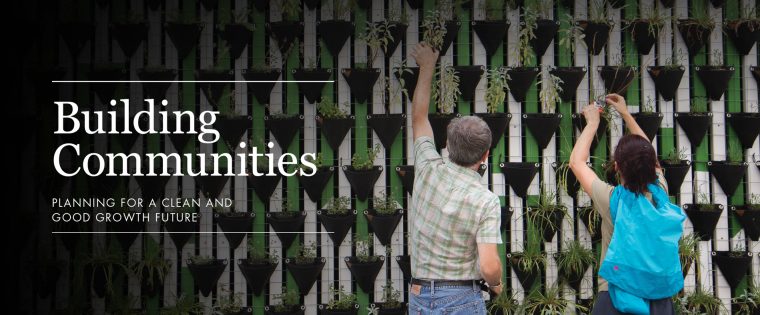Building Communities
planning for a clean and good growth future
Author: Zayn Qureshi |

There is perhaps no greater issue driving division in British politics than the serious gap between aspirations for home ownership and the malign effects of constrained supply. This situation, in which we don’t build or supply enough affordable homes in places where people not only just wish, but need to live, is the unhappy reality for a younger generation seemingly permanently priced out of the housing market. If we are to render a more rational housing market, one broadened with a wider affordable mix of property types and tenures, we are going to have to face down and overcome all that makes the current broken system.
This requires a far better approach to managing the plurality of interests involved, with both greater rights and increased responsibilities placed on councils, developers, and communities. It requires a robust understanding in central government of the necessity of community involvement, and a broad understanding in place of how best to maximise the value of development for everyone involved.
With this in mind, ‘Building Communities – Planning for a Clean and Good Growth Future’ presents a case for a stewarded model of land and housing delivery to better tie together the interests of stakeholders, including the community, developers, and local planning authorities, at the local level. Done so based on a broad study with extensive engagement of experts, practitioners, and activists on all sides of the great housing debate.
Download the executive summary
Key Points
The case for community in planning for the future
Reforms to the planning system have long been seen as the direct path to solving the housing crisis. The Planning for the Future White Paper and subsequent Planning Bill are the latest in a long line of such attempts. Launched in August 2020, the White Paper promised a radical overhaul of the planning system through the stripping away of red tape. While it has proven to be controversial, there is a shared understanding of the need to adapt the system to modern day requirements.
There is increased antagonism between the key stakeholders of a housing-led recovery, including community activists, developers, and local planning authorities. Each are dealing and are concerned with differing priorities in addressing the crisis. Community activists in planning share a common belief that there is not enough engagement in the process of planning and development, but it is important to understand that ‘the community’ contains many diverse views that need to be equally considered. When it comes to the planning and development system, there are a number of avenues for engagement at different levels. At the community level, the most significant are neighbourhood plans and local design codes.
The housing crisis is a multidimensional issue. It manifests in several ways. Therefore, it can hold different meanings for people across the country. In some places this manifests as a supply crisis, in others a crisis of demand; in any case, the nature of the housing market is intrinsically connected to local economies. The housing crisis is thus inseparable from the levelling up agenda and its goal of reducing inter-regional equality.
Working together towards better growth
Robust infrastructure lies at the core of healthy and vibrant communities. The provision of infrastructure within the planning system is covered through the Community Infrastructure Levy (CIL) and Section 106 Planning Obligations. Planning reforms propose to replace the CIL and s106 developer contributions and streamline them into one through a new National Infrastructure Levy in order to make infrastructure delivery easier. However, concerns remain over aspects of the proposed levy’s impact on strategic thinking.
Taking forward lessons learned from the pandemic into a housing-led recovery will entail designing and building communities that harness the aesthetic and health benefits of the natural environment. The manner in which we plan for and build communities will necessarily involve giving due consideration to public health factors if we are to develop prosperous, healthy, and happy places. Beyond the immediate living environment, there is widespread agreement that improving the efficiency of the provision of energy services is an important contributor to meeting Paris Climate Accord goals. There are two options for energy efficient homes: retrofit and net zero new builds. Carbon offsetting during development is another key factor in corporate sustainability and the reduction of emissions.
Given the centrality of the skills agenda to levelling up, and the challenges identified in the Plan for Growth regarding persistent shortages of technical skills in sectors including construction and manufacturing, creating opportunities for individuals to skill up in their local area will be a key part to building prosperous communities. The skills challenge, coupled with the change in employment patterns experienced over the last year, presents an opportunity for targeted interventions amounting to a ‘good jobs’ recovery. On a wider level, the way in which local and central government drive social value through procurement will be hugely important for raising the skills baseline in place.
A new framework for building communities
The main protagonists for a stewarded model of housing delivery are often held back by the deep antagonism that exists between them. There is a collective feeling that respective concerns are not being listened to, resulting in a breakdown of communication and frustration on all sides. For a community-focused housing-led recovery to take place, local stakeholders need to be working together and toward a shared strategic vision for place. Developers, local authorities, and communities need to understand each other’s needs and priorities and work in a manner that harmoniously delivers the housing and wider infrastructure needed. In achieving this shared strategic vision, a stewardship model for community delivery will prove to be the way forward.
Recommendations
Recommendations for central government:
Make planning underscore good and green growth: Some kind of national effort to collect and pool funding is necessary for the state to take its fair share of the burden towards affordable, mixed-tenure and sustainable housebuilding in the age of Net Zero.
What this spells out is the need for a new route forward, to the evolution of a balanced system in which the planning of new developments unlocks the release of sufficient and fair funding to bolster sustainable growth in new homes across varied tenures.
To this end, Localis recommends the setting up of separate funds as follows, overseen at national level and to address the challenges of generating popular consent for local housing growth and making new developments both sustainable and commercially viable:
– a Capacity Fund for neighbourhood planning
– a Carbon Offsetting Fund for development
- Amend Infrastructure Levy to be paid at the point of commencement on site and to include a ringfenced proportion for affordable housing provision.
- Include Health Impact Assessments as a requirement in the National Planning Policy Framework.
- Define and protect social infrastructure through the National Planning Policy Framework.
- Work to develop a centralised portal where residents can access development plans and decisions for their area, in their entirety and in one place.
- Acknowledge the need for a regional approach to new building – from garden cities in the South East to greater vertical development in major cities – through the creation of new boards for regional spatial planning.
Stewardship model: a strategic framework
Local government should:
- Produce community value charters to provide a transparent picture of how procurement around development is benefiting the local area.
- Work with communities to embed local design codes into neighbourhood plans.
- Produce cultural statements for new developments containing the provision and protection of cultural assets and ACVs.
- Commit to a hybrid model of community engagement around local plan-making with digital outreach combined with more extensive physical events.
- Organise developers forums to bridge the gap between developers and communities around new development.
Communities should be encouraged and supported to:
- Produce neighbourhood plans through statutory bodies (parish councils and neighbourhood forums) which do not undercut government housing targets
Developers should be encouraged to:
- Attend and actively contribute to developer’s forums in support of strong collective place leadership and strategic planning.
- Agree productivity deals with local authorities:
- Local labour market uplift: skills and wages
- For long-running developments of over 200 dwellings, run a local growth board to oversee the productivity deal.
Research sponsored by:

